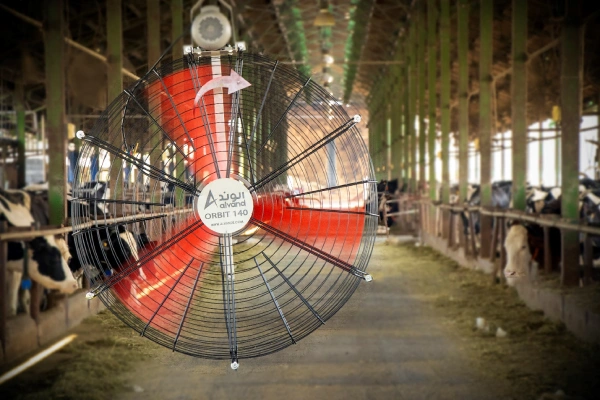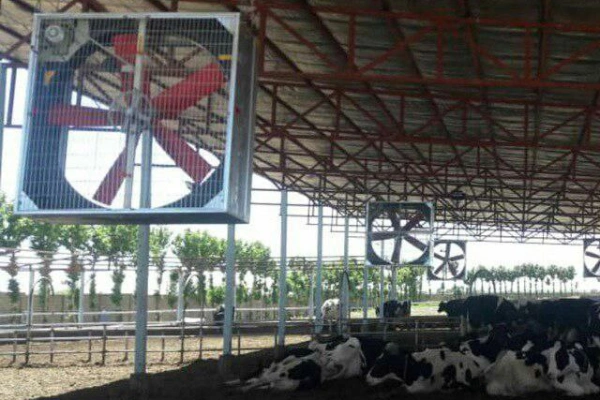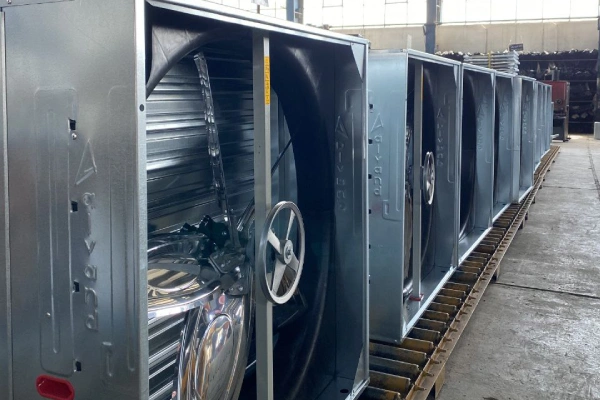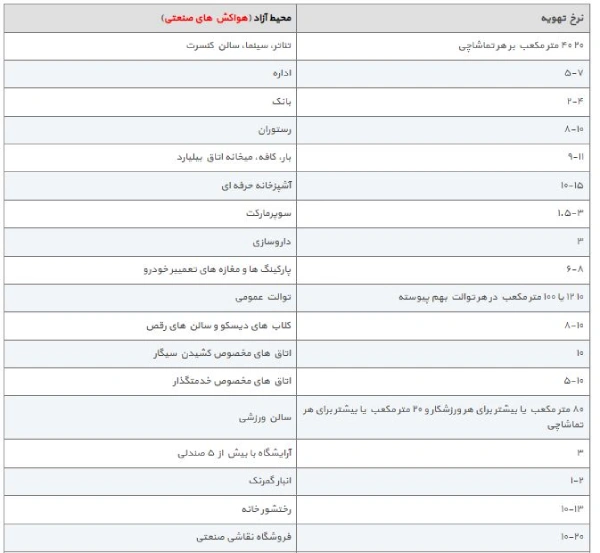Industrial ventilation calculation method

Industrial ventilation is a vital process for maintaining the health and safety of employees in industrial environments. By removing pollutants and regulating environmental conditions, these systems play an important role in preventing occupational diseases and increasing productivity. However, designing an efficient ventilation system comes with challenges such as selecting the right equipment and performing accurate calculations. The purpose of performing industrial ventilation calculations is to accurately determine the required air volume, select the right equipment, and ultimately optimize energy consumption. These calculations help engineers design a ventilation system that reduces operating costs while maintaining employee health.
Table of Contents
- Basic concepts in industrial ventilation
- Methods for calculating industrial ventilation
- Factors affecting industrial ventilation calculations
- Steps for performing industrial ventilation calculations
- Alvand Industrial Group; Supplier of all types of industrial ventilation
Basic concepts in industrial ventilation
Industrial ventilation is a process that is carried out to provide clean and healthy air in industrial environments and remove pollutants. The main goal of this system is to maintain employee health, increase productivity, and prevent damage to equipment.

Types of industrial ventilation
General ventilation: In this method, fresh air is distributed evenly throughout the environment and pollutants are diluted.
Local ventilation: In this method, air is sucked directly from the source of pollution and directed outside the environment.
Pollutant extraction: This method is used to remove specific pollutants such as dust particles, chemical vapors, and harmful gases.
Parameters Effective in Ventilation Calculations
Temperature and Humidity: These two factors affect the level of employee comfort and equipment efficiency.
Air Velocity: Air velocity affects the degree of dilution of pollutants and heat transfer.
Contaminant Concentration: The amount of pollutants in the air determines the volume of air required for ventilation.
Desired Air Volume: The volume of air required determines the number and type of fans. Because the greater the air volume, the more powerful the fan is required. For example, poultry farms use poultry fans with more blades due to the need for a larger air volume.
Common Units of Measurement
Cubic Meters per Hour (m³/h): Used to measure the volume of air displaced per unit of time.
Meters per Second (m/s): Used to measure air velocity.
Kilograms per Cubic Meter (kg/m³): Used to measure the concentration of pollutants in the air.
Understanding these basic concepts is the first step to performing accurate calculations and designing appropriate ventilation systems in various industries. Depending on the type of industry, type of pollutants, and environmental conditions, ventilation calculations must be performed carefully to achieve the best results.
Industrial Ventilation Calculation Methods
In this section, we will introduce the types of industrial ventilation calculations and the factors affecting them in order to design and implement the desired ventilation system by choosing the best method.

1. Calculation based on air exchange rate
This method is based on the complete or partial replacement of polluted air with fresh air. The air exchange rate is determined according to the type of pollution and environmental standards. For this purpose, the minimum air exchange table for different spaces is used. For example, for a painting workshop, the air exchange rate will be higher than for an office, depending on the concentration of solvents.
If you have a poultry house and want to learn how to calculate the ventilation of a poultry house, you can go to the article in question to complete your information.
To calculate the volume of air required to ventilate a space using the air exchange rate method, the following formula is used:
L = V * ACH
L: Required air volume in cubic meters per hour (m³/h)
V: Space volume in cubic meters (m³)
ACH: Air Changes Per Hour or the number of times the air in the space is replaced in a full hour. This value is determined based on the type of activity and the level of air pollution and is usually extracted from standard tables.
Example: Suppose we want to calculate the volume of air required to ventilate a workshop with dimensions of 7 meters long, 4 meters wide and 2.8 meters high. Let’s assume that for this workshop, the air exchange rate is set to 6 times per hour.
First, we calculate the volume of the workshop:
V = length × width × height = 7m × 4m × 2.8m = 78.4 m³
Then, using the formula, the required volume of air is calculated:
L = V * ACH = 78.4 m³ * 6/h = 470.4 m³/h
Therefore, to ventilate this workshop, we need 470.4 cubic meters of air per hour.
Below is the table for calculating industrial ventilation (ventilation rate):
2. Calculation based on the number of people
In this method of industrial ventilation calculations, the required volume of fresh air is determined based on the number of people present in the environment and their level of activity. People with high physical activity (such as factory workers) need more fresh air than people with low activity (such as office workers). To calculate the required volume of air in a space according to the number of people present, the following formula is used:
L = L1 * NL
L: Required air volume in cubic meters per hour
L1: Permissible rate of air volume required for each person in cubic meters per hour (varies depending on the level of activity of the people)
NL: Number of people present in the space
Example: In a production workshop with 50 workers who have average physical activity, the required air volume is calculated as follows:
According to the table, 45 cubic meters of air per hour is required for each person with average physical activity.
Therefore, L1 = 45 cubic meters per hour
Number of people (NL): equals 50 people.
So, L = 45 cubic meters per hour * 50 people = 2250 cubic meters per hour
That is, for this workshop, at least 2250 cubic meters of air must be exchanged every hour to provide fresh and healthy air for the workers.

3. Calculation based on humidity
In spaces where high humidity is a problem (such as industrial kitchens), calculations are made based on the amount of humidity produced and the need to reduce it. Using specific formulas, the volume of air required to reduce humidity to the standard level is calculated.
The following formula is used to calculate the volume of air required to remove excess humidity:
L = D / ((dv – dn) * P)
L: Required air volume (cubic meters per hour)
D: Amount of humidity produced (grams per hour)
dv: Relative humidity of the exhaust air (grams of water per kilogram of air)
dn: Relative humidity of the inlet air (grams of water per kilogram of air)
P: Air density (kilograms per cubic meter)
Example: Suppose that in an industrial kitchen, 1000 grams of water vapor are produced per hour and we want to reduce the relative humidity of the air from 10 grams of water per kilogram of air to 5 grams of water per kilogram of air. At 20°C, the air density is approximately 1.205 kg/m3.
L = 1000 / ((10 – 5) * 1.205)
L = 1000 / (5 * 1.205)
L ≈ 165.56 m3/h
Therefore, to reduce the relative humidity of the air in an industrial kitchen from 10 g/kg of air to 5 g/kg of air, given the above conditions, we need approximately 165.56 m3/h of fresh air.
4. Calculation to remove excess heat
In spaces with high heat generation (such as welding workshops), the purpose of ventilation is to reduce the ambient temperature. Using thermal formulas, the volume of air required to remove excess heat and maintain the appropriate temperature is calculated.
Important note: In many cases, a combination of the above methods is used to accurately calculate the required volume of air. Also, factors such as air penetration through joints and gaps, the type of ventilation equipment and their efficiency should be included in the calculations.
How to install a poultry house fan? A complete guide on how to install it is provided in the article in question, read on for more information.
To calculate the volume of air required to remove excess heat, the following formula is used:
L = Q / (P * Cp * (tv – tn))
L: Required air volume (cubic meters per hour)
Q: Amount of heat produced (kilowatts)
P: Air density (kilograms per cubic meter)
Cp: Specific heat capacity of air (kilojoules per kilogram Kelvin)
tv: Outlet air temperature (degrees Celsius)
tn: Inlet air temperature (degrees Celsius)
Example: Suppose 5 kilowatts of heat are produced in a welding shop and we want to reduce the air temperature from 30 degrees Celsius to 25 degrees Celsius. By substituting the numbers into the formula, the required air volume is calculated.
L = 5000 / (1.205 * 1.005 * (30 – 25))
L ≈ 5000 / (1.205 * 1.005 * 5)
L ≈ 829.4 cubic meters per hour
So to reduce the temperature of a welding shop from 30 ° C to 25 ° C, assuming 5 kW of heat generation, we need about 829.4 cubic meters per hour of fresh air.
Factors Affecting Industrial Ventilation Calculations
Industrial ventilation calculations are affected by various factors that make it possible to accurately determine the required air volume and select the appropriate equipment.
Pollutant Type: The type of pollutant (physical, chemical or biological) determines the calculation method and equipment used. For example, for toxic chemical pollutants, we need high-efficiency ventilation systems and precise filtration.
Pollutant Production Rate: By measuring the pollutant production rate per unit of time, the volume of air required for dilution and removal can be calculated. Increasing the pollutant production rate requires increasing the volume of ventilation air.
Environmental Conditions: Temperature, humidity and air pressure affect the properties of air and, consequently, ventilation calculations. For example, in hot and humid environments, a larger volume of air is needed to reduce temperature and humidity.
Activities performed in the environment: Physical activities of employees, heat and humidity generation by equipment and production processes affect the need for ventilation. More physical activity and higher heat production require a larger volume of air.
Space dimensions: The dimensions of the space (length, width, and height) also affect the volume of air required. The larger the volume of the space, the greater the volume of air required.
Type of equipment and machinery: The type of equipment and machinery used in the environment also affects the amount of pollutant and heat production and, consequently, ventilation calculations.
By considering all these factors and using specialized software, accurate ventilation calculations can be performed and an appropriate ventilation system can be designed and implemented.

Steps to Perform Industrial Ventilation Calculations
The steps to perform industrial ventilation calculations are a multi-step process that aims to create a healthy and safe environment in industrial environments. The steps to perform these calculations are briefly mentioned below:
Determining design objectives: The purpose of designing a ventilation system must be clearly defined. These objectives may include maintaining the quality of the workplace air, removing harmful pollutants, providing sufficient fresh air, and controlling temperature and humidity.
Data collection: Accurate information is collected from the target environment. This information includes the dimensions of the space, the type of activities performed, the number of people present, the type of pollutants present, and environmental conditions.
Selecting the appropriate calculation method: Depending on the effective factors and design objectives, the appropriate calculation method is selected. There are various calculation methods such as calculating based on air movement rate, number of people, humidity, and temperature.
Performing calculations: Using specialized software or performing manual calculations, the required air volume, type of equipment, and dimensions of the ducts are determined.
Ventilation system design: Based on the results of the calculations, the ventilation system is designed. This includes selecting appropriate equipment such as circulating fans, ducts and filters, determining the installation location of the equipment and designing the duct network.
Evaluation and control: After the system is installed, its performance is regularly evaluated. Various air parameters such as temperature, humidity and pollutant concentration are measured and the system is adjusted if necessary.
By carefully following these steps, an efficient and effective ventilation system can be designed that meets the needs of the industrial environment.
Conclusion
The importance of accuracy in industrial ventilation calculations is no secret to anyone. An incorrect calculation can lead to numerous problems such as energy waste, reduced employee efficiency, increased maintenance costs and even accidents. Accurate ventilation calculations not only contribute to the optimal performance of the system but can also significantly reduce operating costs. By designing and implementing a proper ventilation system based on accurate calculations, energy waste can be prevented and the useful life of equipment can be increased. Ultimately, investing in accurate industrial ventilation calculations is an investment in the future and improving working and environmental conditions.
Alvand Industrial Group; Supplier of All Types of Industrial Ventilation
Alvand Industrial Group is one of the pioneers in the production of industrial heating and ventilation equipment in Iran. With years of experience, this group produces a variety of products, including industrial fans, gas jet heaters, industrial water coolers, and poultry ventilation equipment. Alvand, using state-of-the-art technology and expert staff, markets high-quality and efficient products. This group is always looking to improve its products and expand its after-sales services. To view Alvand products, visit the website of this collection.




 2025-01-04
2025-01-04 45 minute
45 minute
 0 comment
0 comment